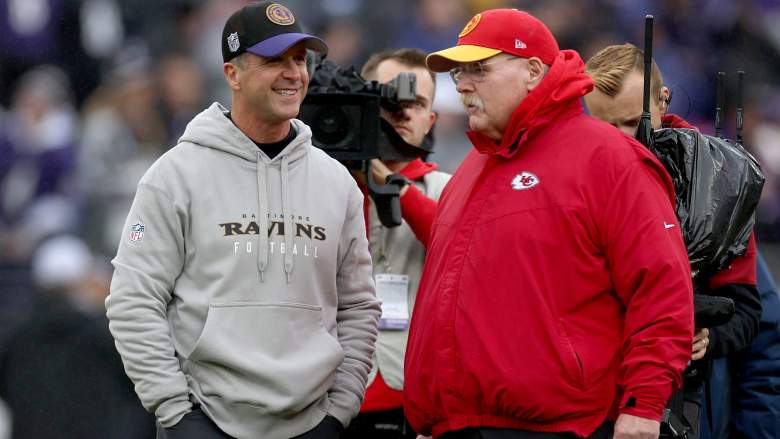
Getty John Harbaugh explained why the Baltimore Ravens hardly ran the ball vs. the Kansas City Chiefs in the AFC Championship Game.
John Harbaugh offered a brief and simple, but ultimately unsatisfactory explanation for why the Baltimore Ravens didn’t run the ball more against the Kansas City Chiefs in the AFC Championship game.
The Ravens attempted just 16 runs during the 17-10 defeat at M&T Bank Stadium on Sunday, January 28, despite entering the game with the NFL’s No. 1 rushing offense. Quarterback Lamar Jackson accounted for eight of those runs, per ESPN.
Harbaugh attempted to justify the surprisingly pass-heavy play calling by saying “it was that type of game,” per Jeff Zrebiec of The Athletic.
As coach speak goes, that’s pretty bland stuff, even taking Harbaugh’s obvious disappointment at coming up a game short into account. The nondescript answer also let offensive coordinator Todd Monken off the hook for a strategy that played into what the Chiefs do best defensively.
Todd Monken, Ravens Abandoned the Run Too Early
Plenty of observers were prepared to be more blunt than Harbaugh about the Ravens’ lack of running. Among them, Jonas Shaffer of The Baltimore Banner noted the obvious disparity: “The NFL’s best rushing offense finished with 11 carries total against one of the NFL’s worst rushing defenses.”
Shaffer’s indignation is justified because he’s pinpointed the fundamental flaw in Monken’s game plan. Namely, not attacking the obvious weakness of the Kansas City defense.
It’s doubly frustrating considering the Ravens had success on the rare occasions they opted to run right at the Chiefs — like this designed QB run by Jackson to convert a 4th down, highlighted by Coach Dan Casey of “The Play Caller’s Club” podcast.
That conversion kept a key drive alive, a march also featuring another successful straight-ahead run. This one involved running back Gus Edwards’ running power, per Casey.
Plays like this helped the Ravens amass a league-high 2,661 yards on the ground during the regular season. The impressive tally was underpinned by an unequaled 4.9 yards per carry.
Numbers like those should have meant more carries for Edwards and fellow back Justice Hill. Instead, they combined for a mere six attempts, much to the chagrin of Ravens Vault co-host Bobby Trosset.
Trosset’s reference to the Ravens departing from their strength speaks to how the hosts were out-coached. It also hints that maybe Monken became too focused on having Jackson win the game with his arm.
Ravens Tried to Force Lamar Jackson to Beat the Chiefs
Having Jackson air it out 37 times in a game ultimately decided by just seven points was unnecessary. Jackson’s performed admirably this season, but forcing him to take on the strength of the Chiefs’ defense was ill-advised strategy.
The Chiefs thrive thanks to a sophisticated mix of physical coverage and disguised pressure. Coordinator Steve Spagnuolo uses both artfully and he was given too many opportunities to go after Jackson.
Spagnuolo’s blitz schemes routinely put Jackson under siege. The Chiefs were able to exploit weak and struggling blockers with free rushers, something detailed by The Ringer’s Steven Ruiz.
Heavy blitzing also filled gaps up front and took away Jackson’s scramble lanes in the second half. It left an under-pressure signal-caller waiting on his receivers to beat standout cornerbacks Trent McDuffie and L’Jarius Sneed.
Jackson’s supporting cast was rarely up to the challenge, but as Ted Nguyen of The Athletic pointed out, “continually testing KC’s elite DBs was a choice.”
This “choice” speaks to Monken and the Ravens perhaps being overly keen for Jackson to win the game as a passer. He’s been more effective throwing the football to a superior stable of receivers in Monken’s more expansive offense.
That’s been the party line all season, but the Chiefs proved these Ravens could still only go as far as their running game would be allowed to take them.
Comments
John Harbaugh Explains Ravens’ Lack of Rushing Attempts in AFC Championship